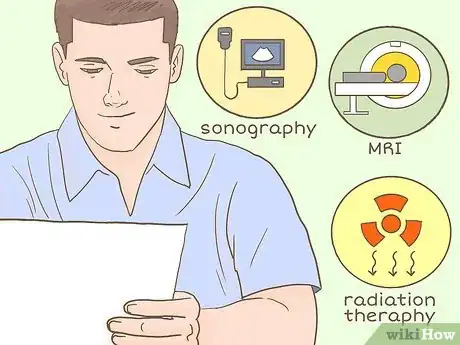This article was co-authored by wikiHow Staff. Our trained team of editors and researchers validate articles for accuracy and comprehensiveness. wikiHow's Content Management Team carefully monitors the work from our editorial staff to ensure that each article is backed by trusted research and meets our high quality standards.
There are 14 references cited in this article, which can be found at the bottom of the page.
This article has been viewed 14,836 times.
Learn more...
Radiographers, also called radiologic technologists, are medical professionals who create images using equipment like X-ray machines and magnetic resonance imaging, or MRI. As a diagnostic radiographer, these images help doctors diagnose patients. Therapeutic radiographers use images to help treat patients. To become a radiographer, you usually need an undergraduate degree, college courses in certain topics, and licensing or certification. You also need specific skills in order to handle the demands of the job. The average pay for radiographers in the United States is around $60,000 per year, and the need for radiographers is growing quickly.[1]
Steps
Studying and Gaining Experience
-
1Decide if you'd like to be a diagnostic or therapeutic radiographer. Diagnostic radiographers use their equipment and skills to diagnose a patient's illness or injury. Therapeutic radiographers help treat someone's illness or injury using different radiation techniques.[2]
- Diagnostic radiographers might work in areas like mammography or magnetic resonance imaging (MRI), while therapeutic radiographers might use radiation to treat diseases like cancer.[3]
-
2Complete an associate degree or bachelor's degree in a science subject. Your country's educational requirements may vary, but most require a two-year or four-year degree in health science topics like biology, anatomy, radiography, or imaging technology to prepare you for the job.
- In the UK, the Health and Care Professionals Council (HCPC) has to approve your degree choice.[4]
- Depending on your school, you may do clinical rotations at a hospital or clinic in your third or fourth year. In clinicals, experienced radiographers offer hands-on learning about equipment and patient care outside of the classroom.[5]
Advertisement -
3Work in a supervised internship to gain experience in the field. After completing a degree, you may have to take on supervised practice with an accredited radiology department. You'll work with other radiographers and radiologists when planning treatment, operating equipment, and helping patients.[6]
-
4Show off your qualifications by receiving certification. Depending on where you live, you may have to receive certification or pass a special test to show that you're qualified to work as a radiographer. Becoming certified means you've passed professional standards for the job.[9]
-
5Earn additional credentials to expand your specialized expertise. You can earn credentials in other specialized areas like mammography, bone densitometry, or vascular sonography. Organizations like ARRT may review your education and moral character on an application, then test you through an exam. [12]
- Check your school or country's radiography organizations for more information on earning additional credentials.
- Other specialized organizations in the U.S. include the American Registry of Diagnostic Medical Sonographers (ARDMS), Nuclear Medicine Technology Certification Board (NMTCB), and Certified Radiology Administrator (CRA).[13]
Learning Soft Skills
-
1Sharpen your communication skills to work well with others. Whether you're a diagnostic or therapeutic radiographer, you'll be working with other healthcare professionals. Practice communicating clearly, accurately, and respectfully with family or friends. Ask them for feedback on how you can improve.[14]
- Radiographers often work closely with radiologists, who read and interpret images done by radiographers.[15]
-
2Be compassionate and honest while helping others. You'll often have to explain procedures to patients who might be in pain. You'll also have to guide them correctly when positioning them around equipment. Being kind yet assertive will ease their fears and make sure your job is done safely.[16]
- Have a friend or fellow radiography student pretend to be a patient. Guide them through a common radiographer process, like preparing to be X-rayed. Ask them if your instructions were clear or if you could have communicated better.
- This is often called having good “bedside manner,” which can prevent patient complaints. It can even help patients recover more quickly.
-
3Be prepared to work irregular hours. After you graduate and enter the radiography field as an intern or new employee, you'll likely have to work late evening hours, weekends, or holidays. If you're used to a set schedule, the change can be stressful.
- Sometimes you can't avoid irregular work hours, but what you can do is stick to a healthy diet and get plenty of sleep and exercise. It will help you perform better at your duties.[17]
Finding a Job
-
1Join a college organization to network with other students. Many universities have organizations that healthcare students can join. These school organizations can support you during education and training, provide job opportunities, and keep you in touch with other radiography students.[18]
-
2Meet other healthcare professionals by joining a social networking group. You can join an online community with members all over the world, like Medical Mingle or MedXCentral. Or, find a local group to join based on your country or region.[19]
- Facebook has plenty of radiographer groups open to the public, like Radiographers, Radiographer Needed, and Radiographers on Call.
-
3Create a chronological resume or CV that proves your skills and experience. You'll list details about your education, credentials and certification you've earned, or internships you've completed. You can also list healthcare organizations and affiliations you've joined, or awards you've won.[20]
- If you're writing a resume, look at sample resumes and choose a layout that will best highlight your experience and achievements.
-
4Check with your school or a hospital for job openings. If you completed an internship during or after college, check with the clinic or hospital for possible job openings. Your college or university probably has a department that gives students career advice. They can point you in the right direction.[21]
-
5Review radiography knowledge and personal stories for interviews. Think of questions you expect to be asked and how you'll answer. Routine interview questions like “why should we hire you?” will likely be asked, but technical questions about handling radiography equipment will come up, too.[22]
- Be friendly and respectful before, during, and after your interview. This includes phone calls or emails to hiring staff, speaking with reception staff, talking to the interviewer, and following up with the employer after the interviewer.
- Make sure your interview outfit looks professional and appropriate for the job. Wear a suit or dress clothes in solid colors and conservative fits, with neutral toned shoes.
References
- ↑ https://www.bls.gov/ooh/healthcare/radiologic-technologists.htm
- ↑ https://www.ucas.com/ucas/after-gcses/find-career-ideas/explore-jobs/job-profile/radiographer
- ↑ https://www.asrt.org/main/careers/careers-in-radiologic-technology/who-are-radiologic-technologists
- ↑ https://www.ucas.com/ucas/after-gcses/find-career-ideas/explore-jobs/job-profile/radiographer
- ↑ https://www.princetonreview.com/med-school-advice/what-to-expect-in-medical-school
- ↑ https://www.prospects.ac.uk/job-profiles/therapeutic-radiographer
- ↑ https://healthtimes.com.au/hub/medical-imaging/10/guidance/nc1/how-to-become-a-radiographer/503/
- ↑ https://healthtimes.com.au/hub/medical-imaging/10/guidance/nc1/how-to-become-a-radiographer/503/
- ↑ https://www.arrt.org/about-the-profession/arrt-certification-and-registration
- ↑ https://www.arrt.org/about-the-profession/arrt-certification-and-registration
- ↑ https://www.arrt.org/about-the-profession/arrt-certification-and-registration
- ↑ https://www.arrt.org/earn-arrt-credentials/requirements/postprimary-requirements
- ↑ http://www.crainfo.org/CRA/Take_the_CRA_Exam/CRA_Eligibility_Requirements/CRA/Take_the_Exam/CRA_Eligibility_Requirements.aspx
- ↑ https://healthtimes.com.au/hub/medical-imaging/10/guidance/nc1/how-to-become-a-radiographer/503/
- ↑ https://healthtimes.com.au/hub/medical-imaging/10/guidance/nc1/how-to-become-a-radiographer/503/
- ↑ https://healthtimes.com.au/hub/medical-imaging/10/guidance/nc1/how-to-become-a-radiographer/503/
- ↑ https://www.ama-assn.org/residents-students/resident-student-health/recipe-success-how-eat-right-med-school
- ↑ https://med.ucf.edu/media/2018/06/2018-2019-Student-Organization-Descriptions.pdf
- ↑ https://www.verywellhealth.com/social-networking-sites-for-medical-professionals-1735951
- ↑ https://www.monster.com/career-advice/article/healthcare-resume-tips
- ↑ https://healthtimes.com.au/hub/medical-imaging/10/guidance/nc1/how-to-become-a-radiographer/503/
- ↑ https://www.monster.com/career-advice/article/toughest-health-care-interview-questions













-Step-9.webp)




















-Step-9.webp)





































